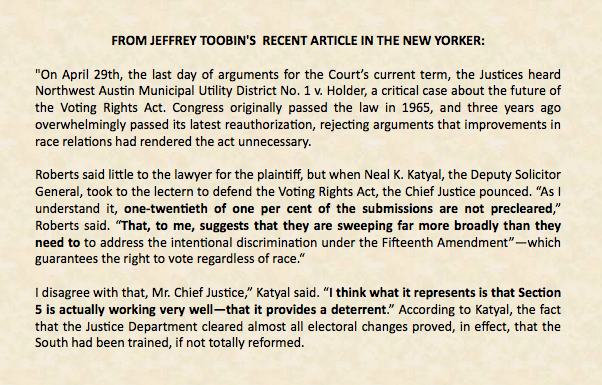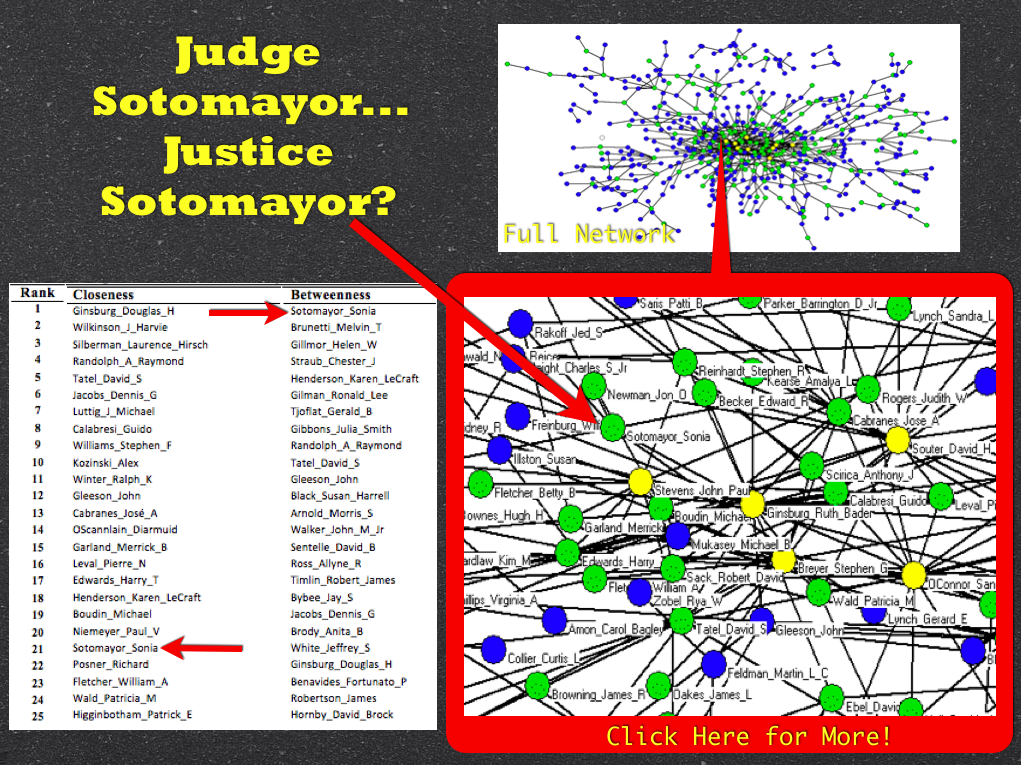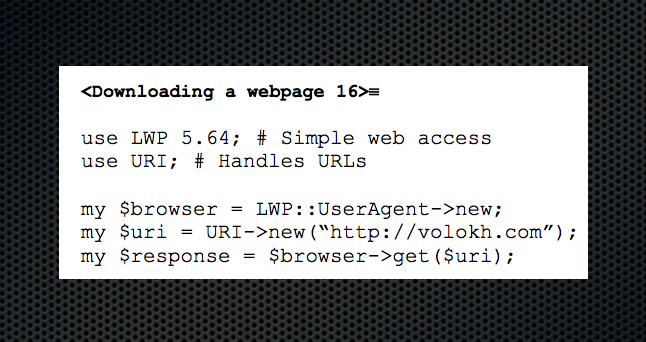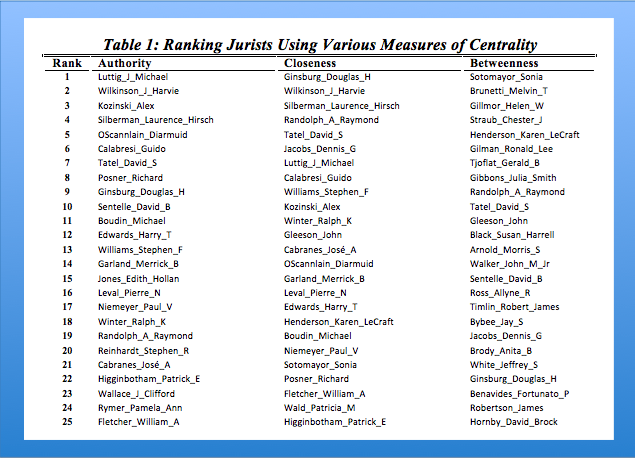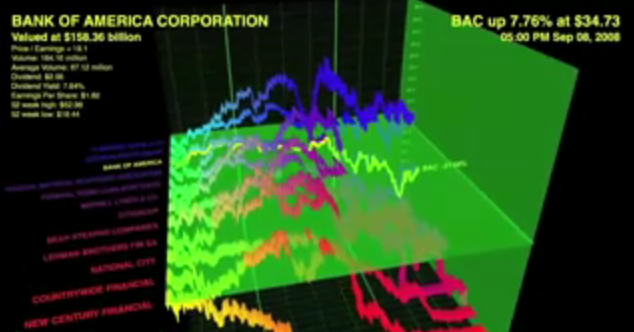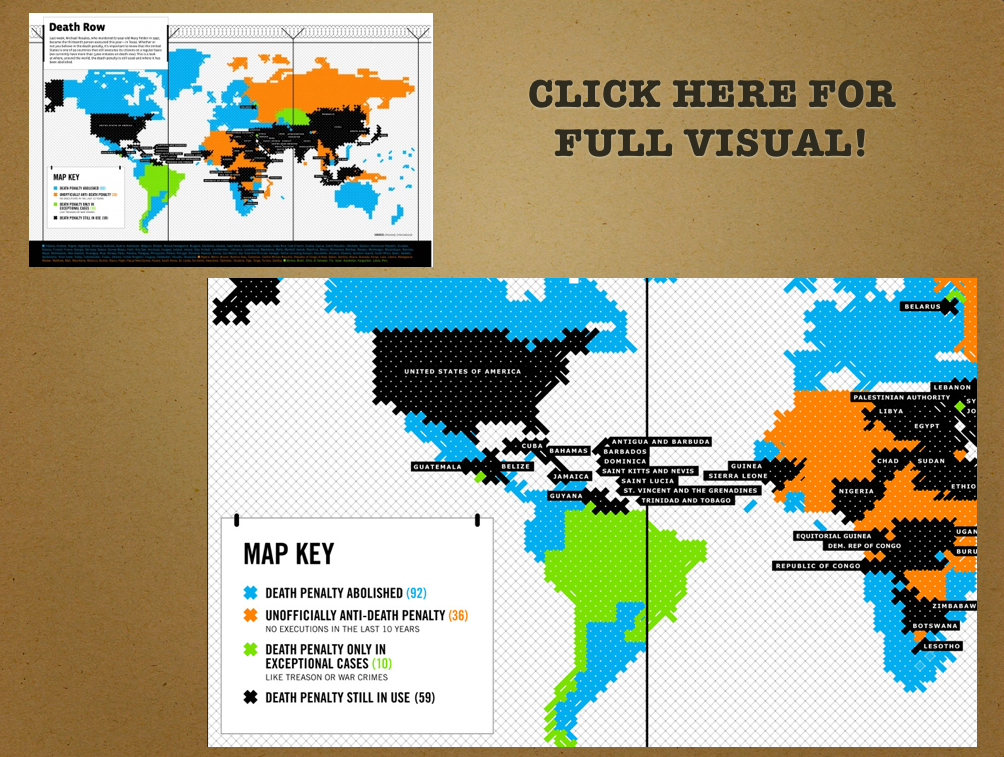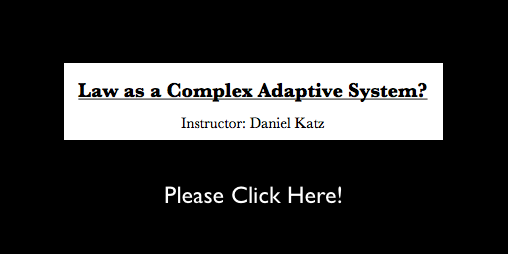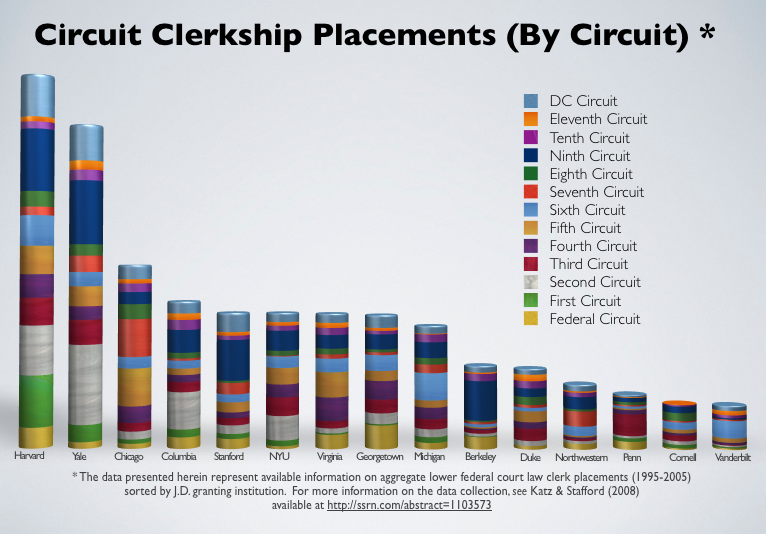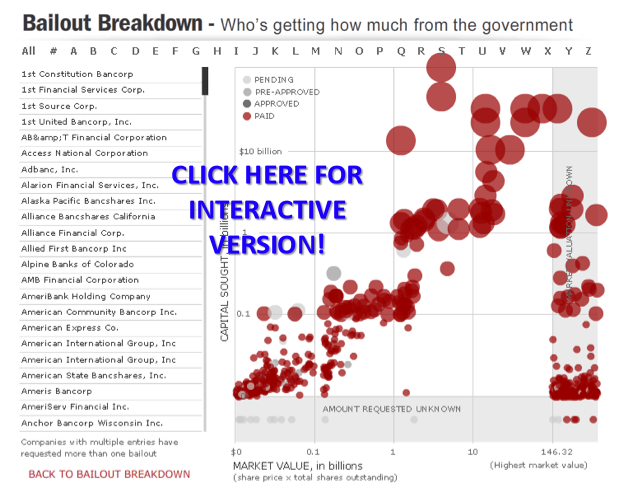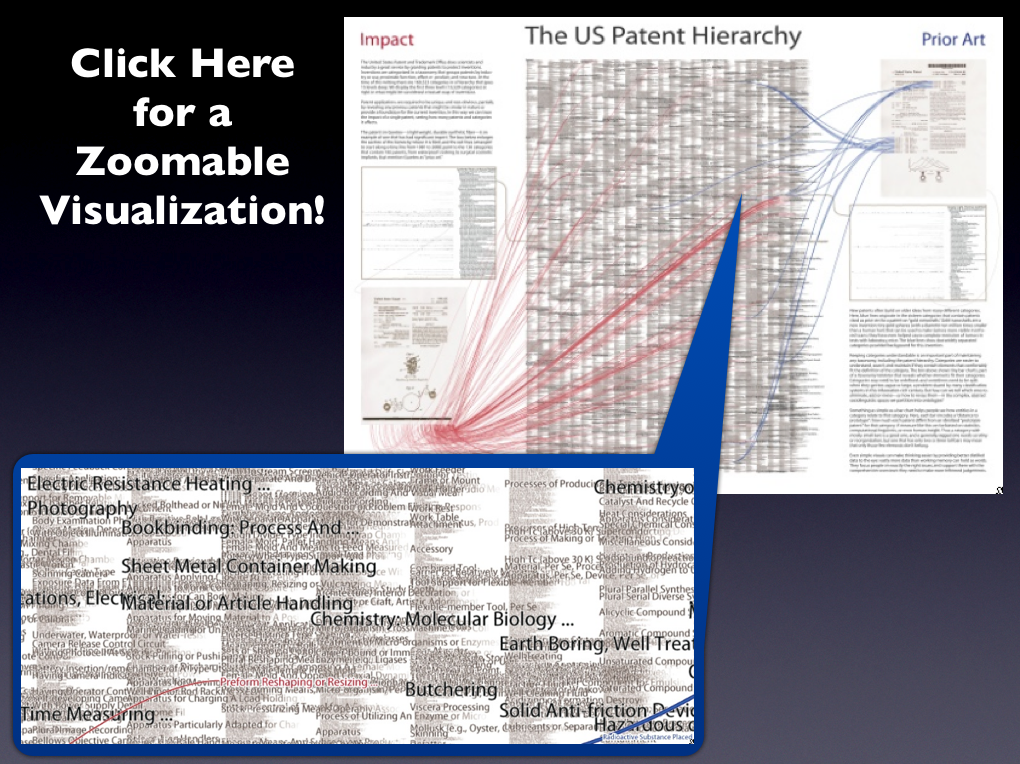 For those of you who may have missed it, here is this visualization of geographic density of job losses around the country. As a person living in Michigan, it is fairly sobering. Click above to see the full movie starting in January 2007 and utilizing data through March 2009.
For those of you who may have missed it, here is this visualization of geographic density of job losses around the country. As a person living in Michigan, it is fairly sobering. Click above to see the full movie starting in January 2007 and utilizing data through March 2009.
Month: May 2009
An Exchange in Need of Empirics and an Analytical or Computational Model
On a recent flight, I read Jeffrey Toobin’s New Yorker Article on Chief Justice Roberts entitled “No More Mr. Nice Guy”. The exchange quoted above is drawn from this article. While I believe it is appropriate to engage empirical data where available, the underlying discussion is not one exclusively subjectable to empirical inquiry. Rather, it is, at least in part, a question in need of a formal theoretic model. Justice Roberts and Mr. Katyal are implicitly discussing a “state of the world” not yet realized but which would be realized if the statute were not to exist. What would benefit the discussion is principled manner to adjudicate between these two inferences drawn above. Namely, it would be useful to fully evaluate what behavior would likely follow if the statute were not to exist.
There exist a variety of mathematical modeling techniques which could inject some much needed rigor into the above discussion. To my knowledge, such an applied model has yet to be offered. The Supreme Court’s decision in the matter is soon forthcoming. Given the nature of the exchange above, there is reason to believe that if Chief Justice Roberts prevails ….we will get our model as the “state of the world” discussed above will no longer be hypothetical….
Data.gov is Now Online
Important thing worth noting … data.gov went online during our break …. From the front page “The purpose of Data.gov is to increase public access to high value, machine readable datasets generated by the Executive Branch of the Federal Government. Although the initial launch of Data.gov provides a limited portion of the rich variety of Federal datasets presently available, we invite you to actively participate in shaping the future of Data.gov by suggesting additional datasets and site enhancements to provide seamless access and use of your Federal data. Visit today with us, but come back often. With your help, Data.gov will continue to grow and change in the weeks, months, and years ahead.”
Marginal Returns and the Mechanics of a Computational Legal Study
As noted earlier, we imposed a break over the Memorial Day Weekend and hope to return to a regular posting schedule this week. For the first post of the week, we want to reach out to readers exclusively socialized in legal or traditional social scientific circles. Namely, we recognize that a number of the approaches highlighted herein are not currently within the mainstream. Thus, many may not be familiar with the methods presented on this blog. So, just to reset ….
On this blog, we discuss scholarship or projects applying a computational, complex systems or informatics approach to questions of potential interest to legal and/or social science scholars. Our approach is unappolgetically interdisciplinary as we attempt to weave together a wide range of scientific methods and intellectual traditions. We have or will feature relevant scholarship from computer science, physics, network science, empirical legal studies, information visualization, new social history, computational politics and economics, mathematical sociology, behavioral biology, neuroscience, anthropology, linguistics ….
We have deeper motivations — but at a minimum — we believe the embrace of the techniques presented herein is justified as a search for intellectual returns on investment. While not applicable to all substantive questions, where appropriate we believe our approach to scholarship can convert higher-hanging fruit into low-hanging fruit.
It is hardly a revelation to note that disciplines tend to be insular. They develop cultures of intellectual reenforcement that can operate to stymie innovation by punishing deviations from status quo practices. Recognizing that switching costs are non-trivial, we want to once again highlight two articles previously discussed on this blog. For those interested in exploring a different terrain, we believe these articles offer both the rationale for and some of the mechanics of a computational approach to legal studies.
The first article, drawn from a recent issue of Science Magazine and authored by some of the leaders in field, highlights some of the possibilities of and potential perils associated with a computational revolution in the social sciences. It is a call to arms to many in social science circles. In a similar vein, Paul Ohm’s forthcoming article represents the law review analog. Among other things, Professsor Ohm offers a concrete playbook for those interested in applying the relevant mechanics to some discrete question of interest. The code displayed above is drawn from his article.
Measuring the Centrality of Federal Judges
Above are some graph statistics from our paper Hustle and Flow: A Social Network Analysis of the American Federal Judiciary. The paper measures the aggregated window of 1995-2005. These, of course, are not the only measures of centrality but they are commonly used in the network science literature. If you are interested — click through to the paper for a description of how these measures are calculated.
We believe these and other elements of the paper offer a good cut on the question of social prestige within the American Federal Judiciary. For example, in the paper we offer a graph visualization where Judge now Justice Alito as well as Judge turned Attorney General Michael Mukasey occupy an extremely central social position (just outside of the Top 25). We think this is useful because their social prestige is measured at a time period prior to their respective nominations. With appropriate control variables for the respective office in question … perhaps we might have been able to predict their nomination?
For purposes of the current Supreme Court opening and conditioned on the selection of a lower court justice with “blue team” credentials, we believe these graph statistics indicate Judge Sonia Sotomayor, Judge Merrick Garland , Judge William Fletcher & Judge David Tatel all occupy high levels of social prestige among their fellow judges and justices. Debate regarding qualifications of various individuals is likely to continue. While certainly not dispositive, we thought it appropriate to offer some social scientific evidence on the question.
President Obama might go outside the tradtional Federal Court of Appeals judge on this round. For example, Governor Jennifer Granholm, Solicitor General Elena Kagan and Homeland Security Secretary Janet Napolitano appear to be on the short list. However, keep these names in mind as this is probably not President Obama’s last nomination to the high court.
Various Explanations for the Financial Crisis-(From Information Aesthetics)
While the explanations might be imperfect in some respects, we are following the lead of Information Aesthetics and linking you to some videos potentially useful for explaining the financial crisis to a lay audience. Click above and it will lead you to several interesting videos … from there it is possible to traverse the YouTube graph out to see many others.
Death Penalty Around the World — (From Flowing Data)
Blogging is going to be light from here through Memorial Day …. but we will back to a more typical posting cycle in late May. In the meantime, we thought we would briefly highlight an interesting visual we saw over at Flowing Data. This visual produced by Good Magazine maps the use of the death penalty across various countries.
Syllabus–Modeling Law as a Complex Adaptive System
Several months ago, I put together this syllabus for use in a future seminar course Law as a Complex System. A number of my friends and colleagues noted that if were to actually use this syllabus in a course, it would be necessary to reduce the total reading in contained herein. While I completely agree, I still thought I would post it to the blog in its current form. I am proud to say that I am an award winning instructor. Notwithstanding, I am always interested in improving my pedagogical skills. Thus, if you see any law related scholarship you believe should be included please feel free to email me.
Data on the Law Clerkship Tournament: Take 2
Highlighting underlying data Derek Stafford and I collected for our article Hustle and Flow: A Social Network Analysis of the American Federal Judiciary — here is some additional information on the law clerk tournament. In the original post, we highlighted both Circuit and District Court Clerkship Placements for the 1995-2005 period.
Using only the Circuit Court data, we thought it might be interesting to consider how those placements are distributed across the various circuits. At first glance, observe the regional or home turf bias contained in the placements (Penn 3rd Circuit ; Vanderbilt 6th Circuit). Furthermore, consider institutions whose placements are highly concentrated (Berkeley 9th Circuit) versus institutions with more diffuse placements (Michigan, Chicago).
The Bailout Breakdown from the Associated Press
Datavisualization.ch/ recently highlighted this interactive “Bailout Breakdown” offered by the Associated Press….. “Bailout Breakdown from Associated Press is an interactive applet that lets the user analyze the recipients and amounts of the $700 Billion bailout plan from the American government. The data is presented as a scatterplot with additional information about the representations when the hovers over a plotted item. The markers are color coded to distinguish between pending, pre-approved, approved and paid status.” At the end of his post, Benjamin Wiederkehr offers some principled critiques of the visualization techniques employed by the authors. Notwithstanding, we still thought it was still worthy of highlighting.
Classifying the US Patent Hierarchy
The United States Patent and Trademark Office patent classification scheme organizes 3 million patents into about 160,000 distinct patent classes. This visualization by Katy Börner, Elisha Hardy, Bruce W. Herr II, Todd M. Holloway, & W. Bradford Paley considers the organizational schema used to classify patents at the US Patent Office. Their article Taxonomy Visualization in Support of the Semi-Automatic Validation and Optimization of Organizational Schemas was published in the Journal of Informetrics in 2007.
From the Abstract: “The taxonomy visualization and validation (TV) tool introduced in this paper supports the semi-automatic validation and optimization of organizational schemas such as file directories, classification hierarchies, taxonomies, or other structures imposed on a data set for organization, access, and naming. By showing the “goodness of fit” for a schema and the potentially millions of entities it organizes, the TV tool eases the identification and reclassification of misclassified information entities, the identification of classes that grow too large, the evaluation of the size and homogeneity of existing classes, the examination of the “well-formedness” of an organizational schema, and more.”
The Real Estate Roller Coaster — Visualizing the Speculative Bubble
We are working hard to produce more original content for the site. In the meantime, we want to share some of our favorite projects and papers. Many of you have probably seen this visualization of housing prices–including the run up to 2007. For those of you not previously familiar, the authors plotted inflation adjusted US Home Prices (1890-2006) on a roller coaster! Pretty creative stuff….
Perils of Interdisciplinary Scholarship — Evading the Discipline Police?

It is difficult to traverse the broad disciplinary landscape. We feel so fortunate to work with a community here at Michigan which is committed to resisting those who seek to restrict intellectual innovation–individuals we characterize as the disciplinary police. Since starting this blog, we have received several emails from legal, social and physical science scholars interested in intellectual exploration, intellectual diversity. We appreciate their encouragement and will proudly continue to privilege “exploration over exploitation.”
In that vein, we wanted to offer some of our favorite recent papers drawn from a wide variety disciplines….
FIVE PAPERS FROM VARIOUS DISCIPLINES WE WANT TO HIGHLIGHT:
Gergely Palla, Albert-László Barabási & Tamás Vicsek, Quantifying Social Group Evolution, Nature 446: 664-667 (5 April 2007)
John Mikhail, Universal Moral Grammar: Theory, Evidence, and the Future, 11 Trends in Cognitive Sciences 143 (2007)
Jenna Bednar & Scott Page, Can Game(s) Theory Explain Culture? (The Emergence of Cultural Behavior Within Multiple Games), Rationality and Society, 19: 65-97 (2007).
Riley Crane & Didier Sornette (2008) Robust Dynamic Classes Revealed by Measuring the Response Function of a Social System, Proc. Nat. Acad. Sci. 105: 15649-15653.
Frans de Waal, Kristen Leimgruber & Amanda Greenberg (2008). Giving is Self-Rewarding for Monkeys. Proc. Nat. Acad. Sci. 105: 13685-13689.
Judge Sonia Sotomayor ⇒ Justice Sotomayor?
Justice Souter’s recently announced retirement has generated significant speculation regarding the potential nominee President Obama might select.
Barring some unknown skeleton in her closet, if President Obama seeks to (1) select a Federal Court of Appeals Judge and (2) increase the diversity of the Court on multiple dimensions …. well … Judge Sotomayor would have to be the frontrunner.
The picture and graph statistics pictured above are drawn from our paper Hustle and Flow: A Social Network Analysis of the American Federal Judiciary. In the paper, we offer a mapping of the social topology of the American Federal Judiciary. Built upon data aggregated over the Natural Rehnquist Court (1995-2004), we find Judge Sotomayor holds a position of significant social prominence.
To read more on operationalization, etc.—click on the slide above or click here.
A number of commentators have suggested President Obama might forgo nominating a sitting judge — instead choosing an academic or politician. This is certainly a possibility and in that vein let me reveal my bias in favor of Gov. Jennifer Granholm (for whom I formerly worked).

